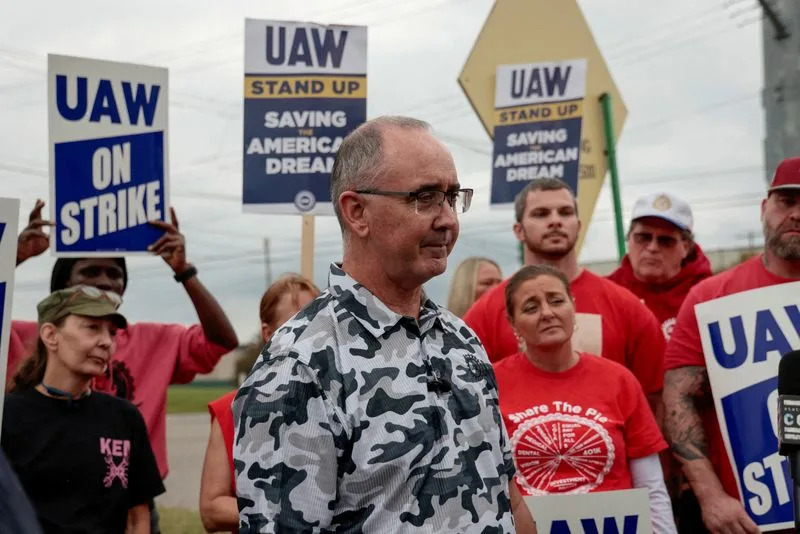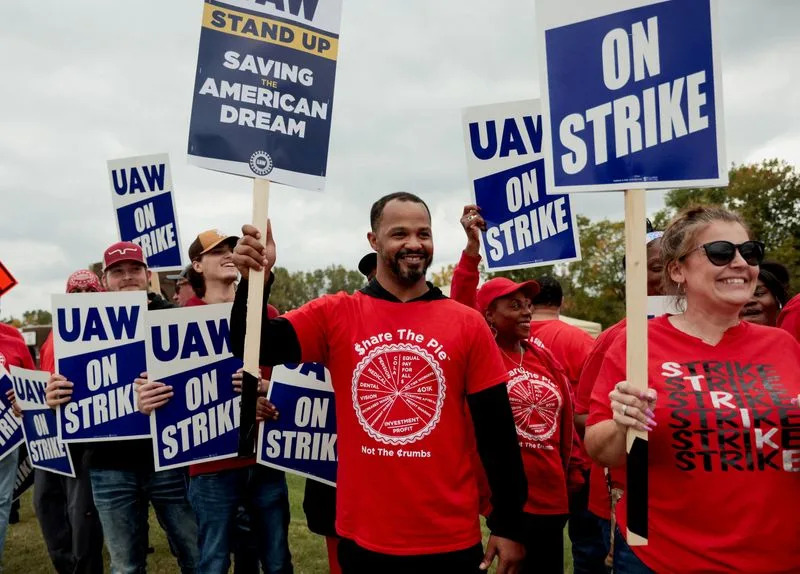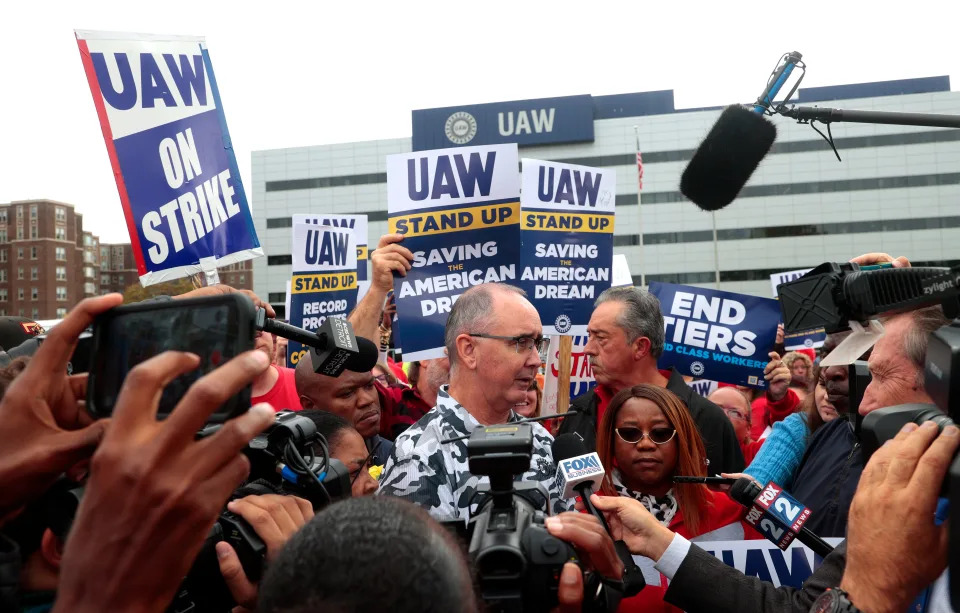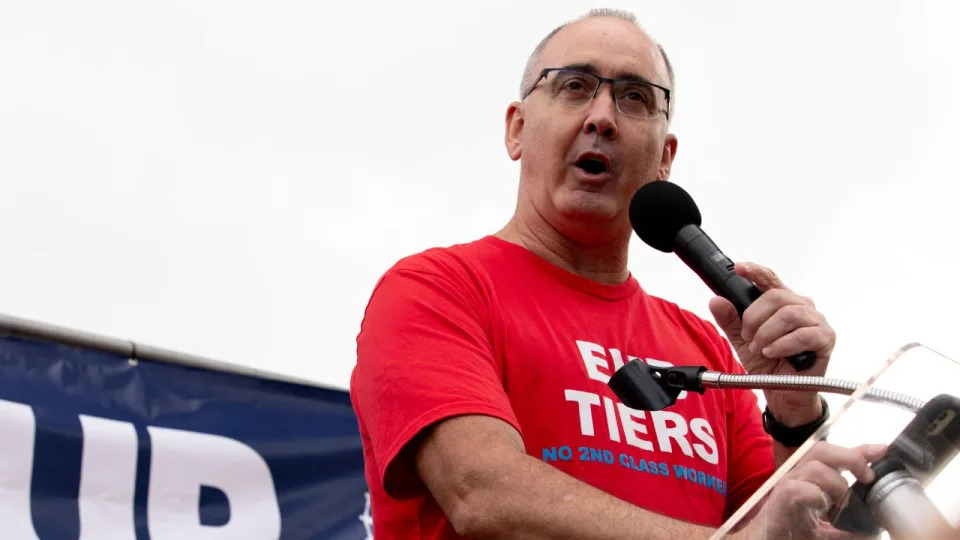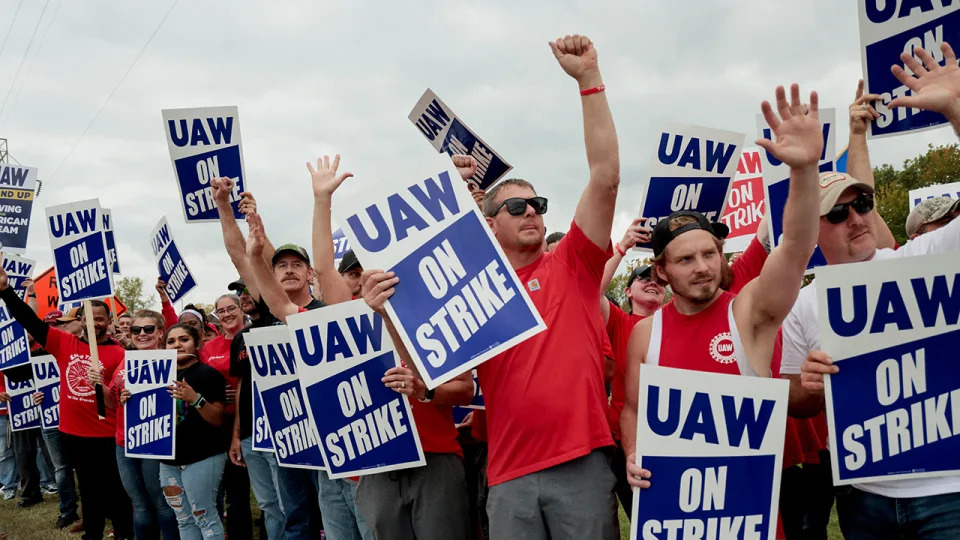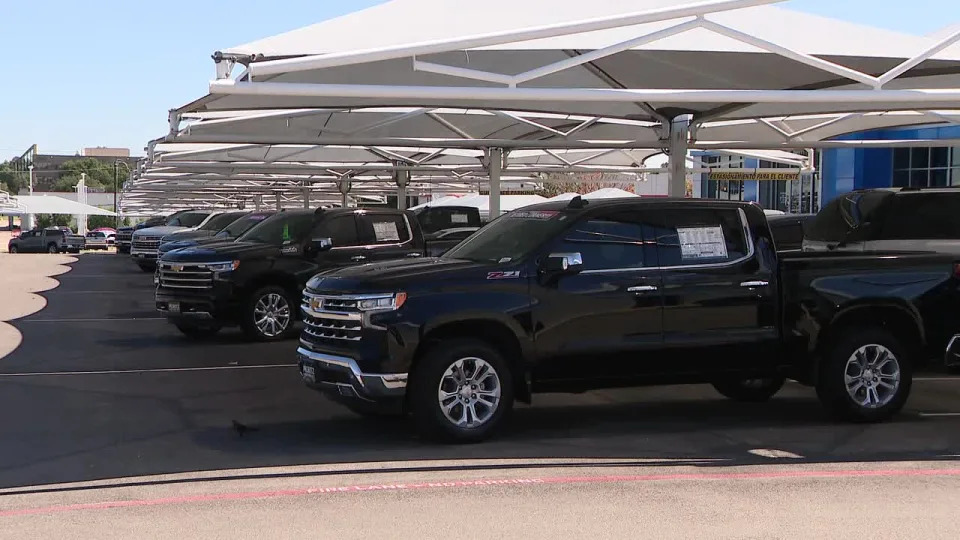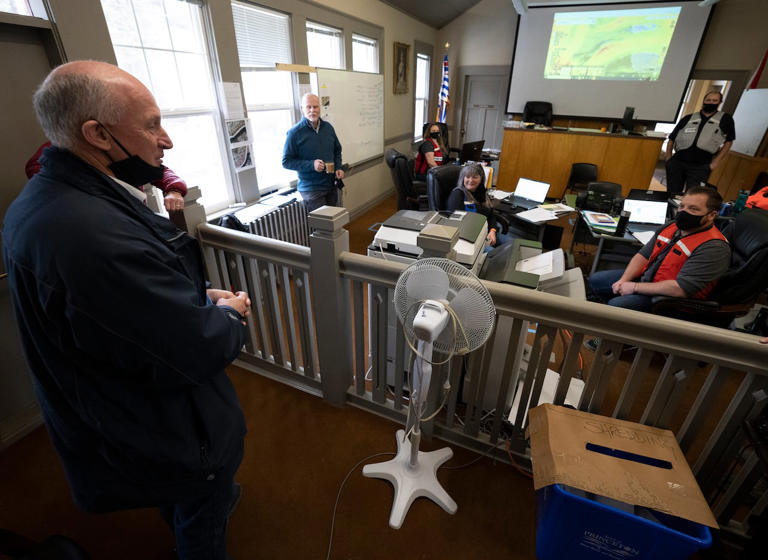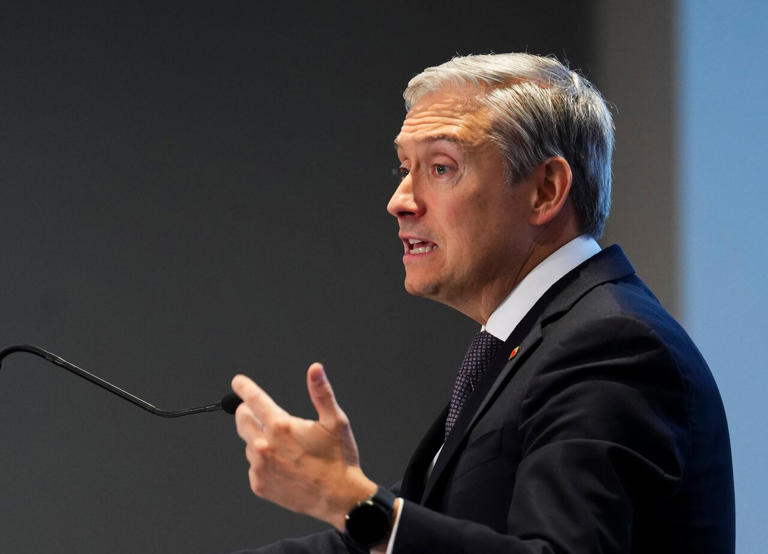PUBLISHED FRI, OCT 6 2023
Spencer Kimball@SPENCEKIMBALL
KEY POINTS
Kaiser Permanente workers are threatening further strikes if executives don’t meet their demands over health-care staffing and job outsourcing.
More than 75,000 workers are currently on strike in California, Colorado, Washington and Oregon.
The strike is scheduled to end at 6 a.m. Saturday local time.
Bargaining sessions between executives and workers are scheduled for next Thursday and Friday.

Striking Kaiser Permanente workers hold signs as they march in front of the Kaiser Permanente Vallejo Medical Center on October 06, 2023 in Vallejo, California.
Justin Sullivan | Getty Images
Kaiser Permanente workers on Friday threatened further strikes if executives don’t meet their demands over health-care staffing and job outsourcing.
More than 75,000 Kaiser workers are scheduled to end a three-day work stoppage in California, Colorado, Washington and Oregon at 6 a.m. Saturday local time. The current strike, which began Wednesday, is said to be the largest walkout by health-care workers in U.S. history.
Nearly 60,000 of the workers currently on strike are in California where Kaiser is headquartered.
The Coalition of Kaiser Permanente Unions said workers will provide 10 days notice before walking out again.
Bargaining sessions between workers and Kaiser executives are scheduled for next Thursday and Friday.
Disagreements over job outsourcing have become a major sticking point in recent negotiations, according to the coalition. It accuses Kaiser of refusing to limit outsourcing and subcontracting jobs.
Kaiser, the largest health-care nonprofit in the U.S., said Thursday that tentative agreements have been reached in several areas and that the company is committed to negotiating a new contract.
Workers are also demanding long-term investments to increase staffing amid a workforce shortage. The coalition of unions has said the short-staffing crisis has led to unsafe working conditions that are affecting the quality of care patients receive.
By Jenna Portnoy
October 6, 2023
The organization, which serves nearly 13 million patients, said it was hopeful a compromise could be reached even as medical support workers picketed in Virginia, Colorado, Oregon and California. But a solution had not materialized nearly a week after union workers’ contracts expired Sept. 30. The strike, expected to last three days in most places, is set to end at 6 a.m. Saturday, but in a statement Friday, coalition officials said they have not ruled out issuing another 10-day strike notice after that.
Kaiser Permanente strike hits classic labor issues in post-pandemic era
The concerns protesters cited on the picket lines echo those of other health-care workers who launched strikes at hospitals and clinics across the country this year as the industry struggles to move past the burnout and staffing issues that have marked the pandemic.
Here’s what’s animating the debate:
More pay
Inflation has rocked Kaiser employees and the nation’s lowest-wage earners, effectively forcing workers to take a pay cut for doing the same jobs. And while inflation is down significantly since last summer, it began to creep back up in August, and health-care workers said jobs with Kaiser — the largest nonprofit private health-care organization in the nation — should better equip them to weather higher grocery bills and child-care costs.
The nonprofit ran a net loss of $4.5 billion in 2022 on $95.4 billion in operating revenue, marking a sharp turn from the previous year’s positive net income of $8.1 billion.
In negotiations, the coalition has requested a $25-an-hour minimum wage for workers, annual pay increases of 7 percent for the first two years of the contract and 6.25 percent increases for the latter two years.
Kaiser has said it would raise minimum starting pay to between $21 and $23 an hour, with annual raises of between 3.5 and 4 percent, officials said in a statement Friday. The coalition of unions said starting pay varies by position and region but that many Kaiser employees earn less than $20 an hour. A Kaiser spokeswoman said Friday that the average hourly rate for coalition employees is $35.75 an hour, or about $74,000 annually plus benefits.
5 things to know about the Kaiser strike if you’re a patient
Increased staffing
The pandemic exacerbated a long-standing staffing crisis in health care, further straining workers who already were white-knuckling their way through shifts that put them and their families at risk of contracting the coronavirus. The task was especially daunting before vaccines and treatments were available, when questions abounded about how the virus spread.
During that time, health-care workers retired or sought less-taxing, higher-paying jobs in droves, leaving those who remained more stressed. As patients who put off routine care returned, workers found themselves confronted with an onslaught of more work with fewer employees. They pressed the company to beef up hiring to accommodate the crush of patients and help them return to a sense of normalcy.
Kaiser officials say all health-care organizations have struggled to fill vacancies post-pandemic.
Lots of jobs at stake
Doctors and registered nurses, whom patients might think of first when they visit a medical office, are not the ones striking. Instead, critical support staff and other direct caregivers, who are just as likely to impact the flow and quality of care, are protesting for a new contract.
They include licensed vocational nurses, emergency department technicians, radiology technicians, ultrasound sonographers, teleservice representatives, respiratory therapists, X-ray technicians, certified nursing assistants, dietary services, behavioral health workers, surgical technicians, pharmacy technicians, transporters, home health aides, phlebotomists, medical assistants and housekeepers.
In Virginia and D.C., pharmacists and optometrists also were affected. Many who walked the picket line outside Springfield Medical Center said they had the support of colleagues who will be negotiating their contracts soon.
A strong moment for labor
The screenwriters guild last week reached a tentative agreement with Hollywood studios to end a nearly five-month strike, and in July, 340,000 UPS workers won their strongest contract in decades on the strength of a strike threat alone.
The next in-person bargaining session is scheduled to begin Oct. 12, Kaiser and coalition officials said Friday in separate statements.
Lauren Kaori Gurley contributed to this report.
Michael McQuarrie, Director of the Center for Work and Democracy, Arizona State University
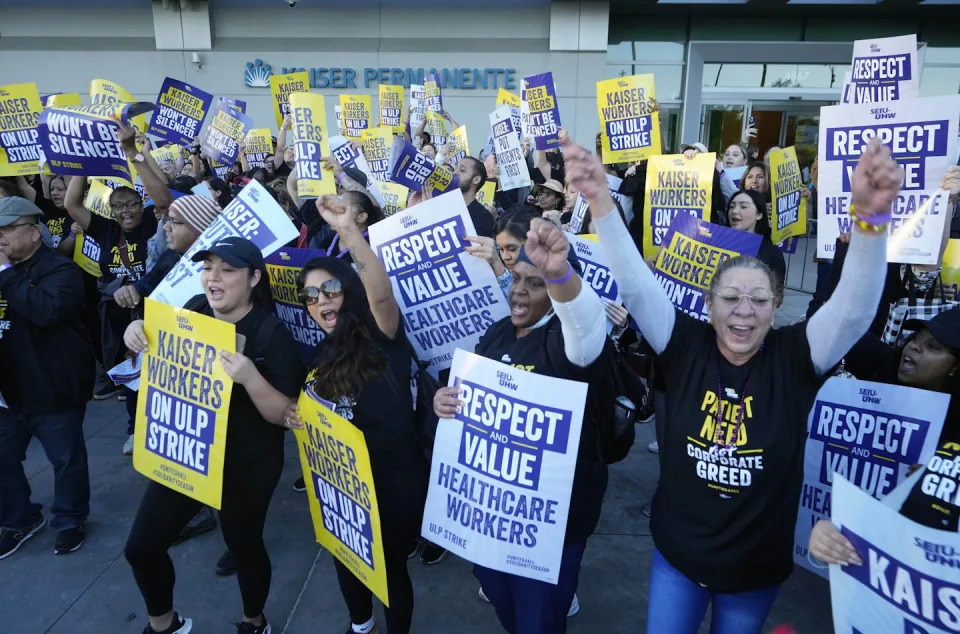
Kaiser Permanente health care workers in five states and Washington, D.C., are rallying against low wages and understaffing that they say is undermining patient care. AP Photo/Damian DovarganesMore
More than 75,000 Kaiser Permanente health care workers began a three-day strike in Virginia, California, Colorado, Washington state, Oregon and Washington, D.C., on Oct. 4, 2023, after company executives and eight unions representing aides, techs, support staff and other employees failed to agree on the terms of new contracts. This is the largest U.S. health care strike on record. In a statement it released when the walkout started, Kaiser asserted that it wanted to reach a deal soon with the striking workers.
Although hospitals and emergency rooms are still open during the strike, and Kaiser is making use of temporary workers, many of its noncritical services are temporarily closed or operating under reduced hours. The strike does not include any nurses unions or doctors.
The Conversation asked Michael McQuarrie, an Arizona State University sociologist who directs its Center for Work and Democracy, to explain why this strike is happening now and how labor actions like this can affect patient care.
1. Why is this historic strike happening now?
The two main reasons are concerns over staffing levels and practices and dissatisfaction with pay that hasn’t kept up with inflation and was too low to begin with.
Kaiser says its options are limited due to a national shortfall in all sorts of health care workers, including home health aides and nurse practitioners. Workers counter that higher pay and better working conditions would attract more applicants.
Health care workers have long worried that inadequate staffing is undercutting the quality of care for patients – this has been a central issue in contract negotiations and strikes for years. But the COVID-19 pandemic greatly exacerbated the problem.
At the same time, inflation has outstripped negotiated wage increases for Kaiser workers. Kaiser is currently offering some workers in Northern California and Washington state 4% annual raises for the four years covered by the new contract and lower raises for everyone else. The unions have rejected this offer, which they say would not make up for past inflation and would unnecessarily create different wage scales based on the region where workers are located.
2. Has Kaiser’s financial management played a role too?
Kaiser, which provides health care for 12.7 million Americans, took in US$95.4 billion in revenue in 2022 but ran a $1.2 billion operating loss that it attributed to “strong economic headwinds in the financial markets” – suggesting that its investments were to blame rather than its health care operations.
For 2021, Kaiser reported that it had about $56 billion in unrestricted cash and investments, excluding assets tied to employee and retiree pensions.
Kaiser’s profits in the first half of 2023 totaled about $3.4 billion, however. And with the exception of its losses in 2022, Kaiser has been consistently profitable for years.
Concerns over low worker pay are growing while Kaiser’s executive compensation is increasing. As of 2021, its CEO Gregory Adams was making more than $15.5 million a year in pay and “other” compensation.
3. But isn’t Kaiser a nonprofit – and does that mean it has any special obligations?
Like many health care systems, Kaiser is a nonprofit. This means it pays very little in taxes. In exchange for their special tax status, nonprofits are supposed to provide public benefits.
Nonprofits may make more money than they spend, but they can’t distribute profits to its shareholders. Nonprofit executive compensation must be “reasonable,” according to the Internal Revenue Service – although it can be hard to determine how much is too much.
Health care strikes are not unusual, with more than 40 occurring in the past two years. However, the industry and the workforce are heavily fragmented, which means that these strikes tend to be relatively small.
In September 2022, the Minnesota Nurses Association took 15,000 members on strike over many of the same issues, such as staffing and inflation. That strike, which lasted three days, was the largest health care strike in U.S. history by that point in terms the number of workers involved.
Prior to that, the largest was probably another Minnesota strike in 2010, in which about 12,000 nurses walked off the job for 24 hours.
Kaiser has experienced much smaller strikes in the past, such as a walkout in 2015 of about 75 mental health clinicians.
5. How much are patients harmed during health care strikes?
It depends on the strike, but usually not much.
Critical care Kaiser facilities will remain open, though the strike will likely cause some delays in care due to short staffing and long lines.
Some appointments and elective procedures at the affected hospitals are being postponed, and nonessential functions like labs and radiology departments are temporarily closed or their hours are being reduced.
Nurses, who are very important bedside caregivers, are part of a different coalition of Kaiser unions. While they won’t be on strike, they may have to help cover work not being done by aides and other support staff who are on the picket lines.
This article is republished from The Conversation, an independent nonprofit news site dedicated to sharing ideas from academic experts.
It was written by: Michael McQuarrie, Arizona State University.
Read more:
Worker strikes and union elections surged in 2022 – could it mark a turning point for organized labor?
Waves of strikes rippling across the US seem big, but the total number of Americans walking off the job remains historically low
Michael McQuarrie works with and does research on unions and other organizations. The Center for Work and Democracy has received funding from United Healthcare Workers West/SEIU, which is part of the Coalition of Kaiser Permanente Unions.

Outside Kaiser Permanente Zion Medical Center on Friday, Luceli Boggs was among the healthcare workers who picketed on the sidewalk as part of a three-day strike coordinated by the Coalition of Kaiser Permanente Unions.
(Nelvin C. Cepeda / The San Diego Union-Tribune)
A 10-day notice of another strike may be issued after Saturday, union leaders said; bargaining will resume Thursday
The Kaiser Permanente workers’ strike continued into its third and final day on Friday, with the possibility of another strike still up in the air as both sides have yet to reach an agreement.
Bargaining won’t resume until Thursday, with another bargaining session scheduled for Friday.
Meanwhile, another strike could be announced as soon as Sunday. The Coalition of Kaiser Permanente Unions said Friday that it may issue a strike notice after the current strike ends at 6 a.m. on Saturday
However, any such strike wouldn’t begin until 10 days after a notice is issued.
Roughly 75,000 Kaiser workers in multiple states have taken part in a strike that began Wednesday, according to the union — among them licensed vocational nurses, pharmacists and pharmacy technicians, radiology technicians, ultrasound sonographers, surgical technicians, certified nursing assistants, behavioral health workers, medical assistants, optometrists, respiratory therapists, x-ray technicians and hundreds of other positions.
The strike does not include doctors or registered nurses.

Kaiser workers head into final day of three-day strike with no agreement Oct. 5, 2023
Replacement workers have been brought in to fill in jobs. Kaiser Permanente has said the strike may cause high call volumes and longer wait times for patients.
Kaiser has said its hospitals, emergency departments and pharmacies would remain open during the strike, but some laboratories have closed, including labs in Bostonia, Carlsbad, Carmel Valley, El Cajon, Escondido, Rancho Bernardo, Rancho San Diego and Viewridge.
The coalition has said they are striking over concerns about outsourcing and staffing levels that they say are unsafe and have caused high turnover and long patient wait times.
Kaiser offered a $23-per-hour minimum wage for new hires in California starting 2024, rising to $24 in 2025 and $25 in 2026. The union has called for 3.5 percent to 3 percent pay raises for each of a proposed new contract’s four years.
A major issue in recent days, union officials said, has been outsourcing. The union coalition wants limits on outsourcing and subcontracting.
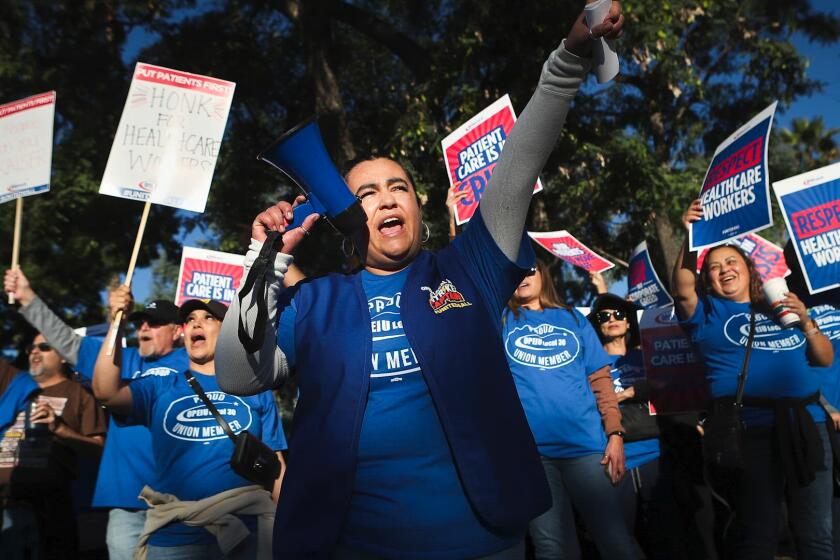
Kaiser has said it has worked to address those concerns by updating an outsourcing side letter of agreement. It also said it has offered increases in funding for employee development and education, improvements to retiree medical benefits and more.
“We look forward to reaching a new agreement that continues to provide our employees with market-leading wages and benefits, and ensures our high-quality care is affordable and available to meet our members’ needs,” said Jennifer Dailard, spokesperson for Kaiser Permanente, in an email Friday.
Kaiser has been bargaining with the national union coalition since April.
Korin Miller
Updated Thu, October 5, 2023
Some patients say the Kaiser Permanente strike, which started Oct. 4, has led to procedures being postponed or canceled. (Amanda Andrade-Rhoades for the Washington Post via Getty Images)
More than 75,000 employees of Kaiser Permanente started a three-day strike on Wednesday, which is being called the largest health care strike in U.S. history. The strike, which affects health care workers and patients in multiple states, is over staffing shortages and what employees say is low pay.
The Coalition of Kaiser Permanente Unions specifically calls this an "unfair labor practice strike" on its website, noting that workers will strike through Saturday morning. "This three-day strike will be the initial demonstration of our strength to Kaiser that we will not stand for their unfair labor practices," according to the site.
"Like all collective bargaining agreements, a number of people across the workforce were looking at ways to improve the work environment," Richard Ricciardi, executive director for the Center for Health Policy and Media Engagement at George Washington University, tells Yahoo Life. A lot of these workers put in extra hours while dealing with understaffing during the pandemic and have continued to do so since, he says.
"Post-pandemic, they've been giving an extra yard to serve their communities, states and country, and they're not feeling valued for that effort," Ricciardi says. "Thus, they're striking to improve working conditions and salary."
The strike is also about safety and quality of care, he says. "The health care workforce is very much concerned about safety and health," Ricciardi says. "There's a pretty direct connection between the quality of the work environment and the ability to provide safe care."
Doctors and many nurses are not involved in the strike, according to the New York Times, but support staff and other employees are. Those include X-ray technicians, receptionists, medical assistants, sanitation workers and pharmacy employees — and that's expected to lead to delays in nonurgent procedures such as cancer screenings, as well as appointment times, Ricciardi says. Some Kaiser Permanent labs have also temporarily closed, the N.Y. Times reports.
Kaiser Permanente is the country's largest private nonprofit health care organization, serving 12.7 million Americans. So what is the strike like for patients and why are workers picketing in the first place? Read a breakdown, below.
How is the strike affecting patients?
Some patients have spoken out publicly about how the strike is affecting them and their families, including having procedures postponed or canceled. Here are their stories:
Lisa Franceschi Schnaidt shared on Facebook that her husband, John, had appointments for lab work and chemotherapy that were canceled due to the Kaiser strike, noting that she was "still reeling" from a call she got about it. "In what universe would second line chemotherapy to a pancreatic cancer patient with metastasis to the lung be considered 'non-urgent appointment or procedure?!'" she wrote. "I’m appalled at this whole thing. Taking our foot off the gas pedal right now cannot be in John’s best interest." Schnaidt also posted on Caring Bridge that she was told her husband would have his appointments next week. "God, I hope so," she wrote.
California resident Walter Adams's wife Sue had her 10-year-old pacemaker replaced last week, but she's experienced complications. “She had some problems with it, her blood pressure skyrocketed, her thinness of her blood got way too thin, so they wouldn’t let her be released [from the hospital],” Adams told CBS 8. Doctors were finally able to stabilize Sue Adams's blood pressure and released her from the hospital two days later, but her follow-up appointment with her cardiologist to check the pacemaker and remove bandages was canceled due to the strike. “The whole thing was really stressful for me because the complications with the surgery, the way that ended and we were worried about what the outcome was going to be Wednesday at the follow up appointment," Adams said.
Michael Signorio told CNN that he spent half a day waiting to get care after suffering from a torn meniscus in his knee. “I spent 12 hours [in the ER]," he said. "You know, it just didn’t sit right. Now, why? Because they’re understaffed, they need more people.” Signorio said he has an appointment in two weeks and he's been trying to see a doctor for three weeks. "I’ve been off work for a little bit now and I’m not liking it, I’m sure work’s not liking it,” he said.
California mom Tiffany Young told NBC News that her son Caden's ear tube surgery, which was scheduled for this week, was postponed until December because of limited staffing. The 17-month-old has suffered from recurring ear infections. "That was really upsetting," Young said, pointing out that the surgery would help relieve Caden's pain and reduce how often he would need to take antibiotics. “We were talking about it all last week, this week, how we’re looking forward to it, how we hope that it’s going to make him feel so much better, and then just getting that call yesterday was so heartbreaking,” she said. “I know that it’s considered minor but, to a parent, when your baby is suffering, it’s super important."
Kaiser Permanente employees are on strike, with several workers saying there's a staffing crisis. (Watchara Phomicinda/Orange County Register via AP) (Watchara Phomicinda/The Orange County Register via AP)
Why are workers striking?
Workers have also spoken out about why they've temporarily walked off the job.
Charmaine Arellano, a medical assistant at the Kaiser Permanente Lakewood medical offices, told Fox 31 Denver that understaffing is a big issue. "Kaiser executives refuse to acknowledge how much patient care has deteriorated or how much the front line health care workforce and patients are suffering because of the Kaiser short-staffing crisis," she said. "We’re taking action because we can’t let this staffing crisis continue."
Many Kaiser Permanente workers are struggling with burnout, Jessica Cruz, a vocational nurse at Kaiser Los Angeles Medical Center, told CBS News. Workers are "trying to do the jobs of two or three people, and our patients suffer when they can't get the care they need due to Kaiser's short-staffing," Cruz said.
Kaiser Permanente health care worker Rocio Chacon told CNN that workers are "exhausted," noting that the facility that she works at reminds her of the poor health care people received when she was growing up in Mexico. "I’m having flashbacks of what it was back home, me growing up," she said. "Coming into the emergency room and waiting to be seen for hours. Or even being left tied in a room waiting for an X-ray or for lab work. You might have a condition that might not be critical, but because you have not been seen within that period of time that could potentially save your life, it can be something very simple that can turn onto a bigger issue.” Chacon also said that some nurses will sleep in their cars because they have to travel two hours to get home because they can't afford the cost of living in California. "As we speak, there are nurses that are sleeping in their cars because of two reasons," she said. "One, they can’t afford cost of living here so they have to move two, three hours [away] and then because of short staff they’re working 14, 16 hours so they’re tired. So their best choice is to be Monday through Friday in their cars."
Ultrasound technician Michael Ramey, who has worked for Kaiser Permanente for 27 years, told CBS News that his job is now stressful due to staffing shortages. "You don't have the ability to care for patients in the manner they deserve," he said. "People are working more hours than they want to be working, and even that creates a problem with patient care — if you know you're going to miss your kid's soccer game," he said. Ramey said he regularly fields complaints from patients about wait times and how long it takes to even get an appointment. "They are telling you how long it took to get the appointment, and then you have to tell them how long it will be to get results," Ramey said. "There's a breakdown in the quality of care. These are people in our communities."
Mikki Fletchall, a licensed vocational nurse based in a Kaiser medical office in Camarillo, Calif., told Fox 5 that workers feel unheard by officials at Kaiser Permanente. "They're not listening to the front line health care workers," she said. "We're striking because of our patients. We don't want to have to do it."
Pamela Reid, an optometrist at Kaiser's Marlow Heights Medical Center in Maryland, told NPR that wait times for an appointment in her clinic were up to 10 business days before the COVID-19 pandemic hit. Now, patients typically have to wait two months to be seen, and the number of optometrists across Kaiser's service regions has dropped from about 70 to fewer than 50, she said. Patients are "really already being affected," Reid said, adding, "Our goal with the strike is to hopefully change that."
Ricciardi says that there has been some misconception about why workers are striking. "There's this idea that people are going on strike because they're greedy," he says. "But in reality, only a very small percentage of money that goes into health care is actually going to health care professionals."
The strike is expected to end on Saturday. Negotiations have hit a stalemate, according to Reuters.
Thousands of Kaiser Permanente health care workers in Southern California and beyond returned to the picket lines Friday for the final day of a three-day strike billed as the largest of its type in U.S. history.
According to the Coalition of Kaiser Permanente Unions, striking workers are planning to return to work at 6 a.m. Saturday.
However, union officials said they may issue a 10-day strike notice on Saturday, potentially setting the stage for further walkouts if a contract agreement is not reached
Kaiser officials said the next “large, in-person bargaining session” is scheduled for Thursday, although in the meantime, “committees and local bargaining teams representing both sides will continue to meet.”
“As frontline healthcare workers conclude the current strike action on Saturday morning, our resolve to advocate for the safe staffing that our patients need has never been stronger,” Georgette Bradford, an ultrasound technician from Sacramento who is a member of the union’s bargaining team, said in a statement released by the union Friday.
“Following this historic work action by tens of thousands of frontline healthcare workers in response to unfair labor practices by Kaiser executives, we are hopeful that the company will refrain from any further violations of federal labor laws as we resume formal talks on Thursday.
“Frontline healthcare workers remain ready to continue taking the necessary steps to protect our patients from the dangers of the Kaiser short staffing crisis and to defend our rights.*
A representative for Kaiser said in a statement Friday morning that most procedures were not delayed by the strike, and contingency plans were in place to minimize disruptions.
“We are fortunate that most procedures were not delayed or deferred, most routine surgeries were not rescheduled and our ambulatory appointment access has been close to normal, in part because we expanded access just prior to the visit and converted many appointments to phone and video.
“Kaiser Permanente remains committed to reaching an agreement that is good for our employees, our members, and our organization, and we will continue to bargain in good faith with our Coalition partners,” according to Kaiser.
The workers’ contract expired Saturday, but bargaining continued over the weekend and again Monday, Tuesday and through the night into Wednesday, to no avail. The strike began at 6 a.m. Wednesday.
“Now more than ever Kaiser Permanente needs to retain and attract qualified healthcare professionals. Outsourcing and subcontracting would have the opposite effect,” Kathleen Coleman, a medical assistant at Arapahoe Primary Care in Colorado, said in a statement released by the union Friday.
An estimated 75,000 Kaiser workers were taking part in the strike, according to the Coalition of Kaiser Permanente Unions. In addition to California, picketing took place in Colorado, Washington, Oregon, Virginia and Washington, D.C.
The coalition has been pushing for higher wages commensurate with inflation, increased staffing and working conditions. The unions have also repeatedly accused Kaiser of bad-faith negotiating, an allegation Kaiser has denied.
“At issue, health care workers say, are a series of unfair labor practices related to bargaining in bad faith, along with simmering staff concerns related to unsafe staffing levels that can lead to dangerously long wait times, mistaken diagnosis, and neglect,” according to an earlier union statement
“After years of the COVID pandemic and chronic understaffing, Kaiser healthcare workers are calling on management to provide safe staffing levels.”
The union has also accused Kaiser of cutting performance bonuses for employees, failing to protect employees against subcontracting and offering wages that fail to keep pace with inflation — all issues that Kaiser has refuted.
“Frontline health care workers are awaiting a meaningful response from Kaiser executives regarding some of our key priorities including safe staffing, outsourcing protections for incumbent healthcare workers, and fair wages to reduce turnover,” Caroline Lucas of the Coalition of Kaiser Permanente Unions said in a statement.
“Health care workers within the coalition remain ready to meet at any time. Currently, the strike continues, and there are no sessions scheduled at this hour.”
Kaiser officials said the most recent bargaining sessions did result in a “number of tentative agreements,” and they insisted the health care system’s latest offers address the union’s demands. Kaiser officials said the company is offering:
— “across-the-board” wage increases in all markets over four years;
— an improved Performance Sharing Plan with the potential for payouts of up to $3,750;
— minimum wages of $23 an hour in California and $21 an hour in other markets; and
— renewal of tuition assistance and training programs.
“We remain committed to reaching a new agreement that continues to provide our employees with market-leading wages, excellent benefits, generous retirement income plans, and valuable professional development opportunities,” according to Kaiser.
The company also affirmed its commitment to hiring, confirming that it has already reached a goal of hiring 10,000 new union-represented employees before the end of the year.
“In total over the past two years, Kaiser Permanente has hired more than 50,000 people to join our teams,” according to the company.
On Wednesday, Kaiser officials issued a statement saying rising inflation has led to a “massive surge” in expenses, and has made it tough for the company to balance taking care of its employees with being affordable to patients.
“As noted in a recent report from the American Hospital Association, rising inflation has led to health care experiencing a `massive surge’ in expenses driven by drugs and supplies, equipment shortages, staffing costs and supply chain disruptions,” Kaiser officials said.
“At the same time, in the wake of the pandemic, demand for care has increased dramatically, as people come in for care that has been delayed. Kaiser Permanente is not immune to these inflationary pressures.”
Among the workers involved in the strike are licensed vocational nurses, emergency department technicians, radiology technicians, ultrasound sonographers, teleservice representatives, respiratory therapists, X-ray technicians, certified nursing assistants, dietary services, behavioral health workers, surgical technicians, pharmacy technicians, transporters, home health aides, phlebotomists and medical assistants, union officials said.




